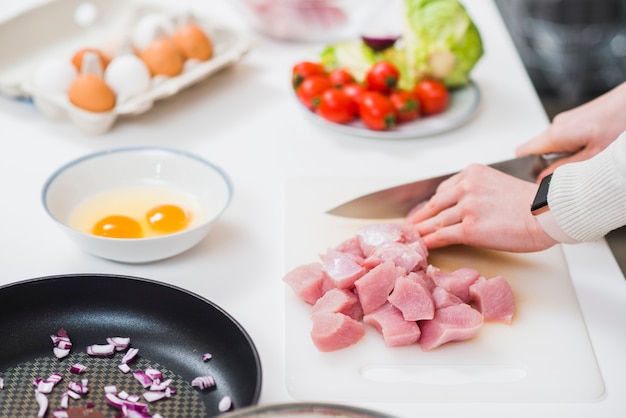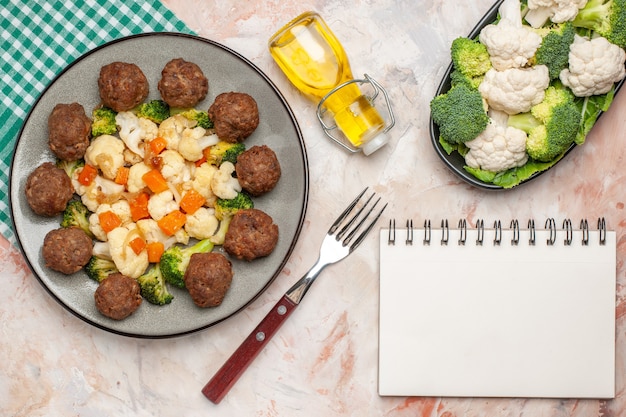As a seasoned home cook, I've spent countless hours perfecting my meatball game. It's a journey, I tell you! There's nothing quite like the satisfaction of biting into a perfectly cooked meatball, bursting with flavour and juicy to the core. But achieving that ideal texture can be a bit of a culinary puzzle, especially when it comes to figuring out the perfect cook time. I've had my fair share of disasters – dry, crumbly meatballs that made me want to throw the whole lot in the bin. But I've also had triumphs – those melt-in-your-mouth masterpieces that made my family sing my praises. So, I'm sharing my hard-earned knowledge and insider tips to help you achieve meatball perfection every single time. Trust me, you'll be saying "Mamma Mia!" with every bite.
(Part 1) The meatball recipe: The Foundation of Success

Before we dive into the nitty-gritty of cook times, let's talk about the recipe. A good meatball recipe is the foundation of success. It's the starting point from which you build a delicious masterpiece. You can experiment with different meat combinations, but I find a blend of pork, beef, and veal works best. They're like the classic trio – each contributing their unique flavour and texture to the symphony of the meatball. A little bit of breadcrumbs helps bind the meat and gives it a lovely texture – imagine a hug from a warm, comforting blanket. And don't forget the aromatics – herbs, spices, and garlic bring life and flavour to your meatballs. They're the secret ingredients that add a touch of magic.
The Meatball Mix: A Symphony of Flavors
The classic meatball mix is a staple for a reason. It's a balanced combination of flavours and textures that's hard to beat. It's like the perfect harmony in a musical composition.
- Ground Pork: Adds richness and a slightly sweet flavour, like a melody that lingers on the palate.
- ground beef: Provides structure and a hearty base, the backbone of the meatball's symphony.
- Ground Veal: Offers a delicate flavour and tender texture, the delicate notes that add complexity.
- Breadcrumbs: Acts as a binder and adds texture, the rhythmic beat that binds everything together.
- Milk: Soaks the breadcrumbs and helps create a moist meatball, like a beautiful crescendo that builds in intensity.
- Egg: Further binds the meat and adds richness, the final note that rounds out the composition.
- Onion: Adds depth and sweetness, the low hum that adds depth and complexity.
- Garlic: Provides a pungent flavour boost, the sharp notes that awaken the senses.
- Parsley: Freshness and a touch of herbal flavour, the bright and cheerful notes that add a touch of elegance.
- Salt and Pepper: Season to taste, the perfect seasoning to bring the whole composition into balance.
Experiment with other herbs and spices to add your own personal touch. I love a bit of oregano and basil for a Mediterranean twist, or some paprika for a hint of smokiness. It's like adding your own signature improvisation to a classic piece.
(Part 2) Sizing Matters: The Perfect Meatball Shape

The size of your meatballs plays a crucial role in cook time. Smaller meatballs cook faster, while larger ones require a longer time. Imagine it as a group of dancers - a smaller group can move more quickly and efficiently than a larger group. I recommend aiming for meatballs that are about the size of a golf ball. This size strikes a balance between cooking time and ensuring even cooking throughout, like finding the perfect middle ground between the graceful movements of a ballerina and the powerful strides of a football player. Too small, and they might dry out before the centre is cooked. Too large, and the outside might burn before the inside is cooked through. Think of it as a delicate dance between the outer crust and the tender heart of the meatball.
Shaping Your Meatballs: A Hands-On Approach
Roll your meatballs gently but firmly to ensure a consistent shape and texture. Avoid over-working the meat, as this can lead to tough meatballs. Imagine molding clay, with gentle but firm pressure. Use your hands to shape the meatballs, or you can use a meatball scoop for a more uniform look. I prefer the hands-on approach, allowing me to feel the texture of the meat and ensure each meatball is firm enough to hold its shape, like a sculptor carefully shaping their masterpiece.
(Part 3) Cooking Methods: Oven vs. Stovetop

The cooking method you choose significantly impacts the cook time. Each method has its own advantages and disadvantages. Think of them as two different paths leading to the same delicious destination.
oven-baked meatballs: A Hands-Off Approach
Baking meatballs is a great option for a hands-off approach. You can simply pop them in the oven and let them cook while you focus on other tasks. Imagine the meatballs as little chefs, working away in the oven without your constant supervision. Preheat your oven to 375°F (190°C) and bake the meatballs for 20-25 minutes, or until they are cooked through and golden brown. The oven provides a consistent and gentle heat, ensuring that the meatballs cook evenly throughout.
stovetop meatballs: A More Controlled Experience
Cooking meatballs on the stovetop allows for more control over the cooking process. You can brown them quickly in a pan over medium heat and then simmer them in a flavorful sauce. This method ensures a crispy exterior and a juicy interior, like a well-seasoned performer, delivering both a powerful performance and an emotional connection. Brown the meatballs for about 5 minutes per side, or until golden brown. Then, add your sauce and simmer for another 15-20 minutes, or until the meatballs are cooked through. The stovetop provides a more immediate response, allowing you to adjust the heat and cooking time as needed.
(Part 4) The Importance of Doneness: Ensuring food safety
Ensuring your meatballs are cooked through is essential for food safety and a delicious result. The internal temperature of the meat should reach 160°F (71°C) to kill any harmful bacteria. Don't rely solely on visual cues, such as colour. A meat thermometer is your best friend. Think of it as a culinary detective, ensuring the meat has been properly cooked. Insert it into the thickest part of a meatball to check the internal temperature. If the thermometer reads 160°F (71°C), your meatballs are cooked to perfection.
Signs of Doneness: A Culinary Guide
While a meat thermometer is the most accurate way to check doneness, there are some visual cues you can look for, like clues in a mystery novel:
- Colour: Cooked meatballs will have a brown, slightly crispy exterior, like the sun-kissed glow of a summer day.
- Texture: They should be firm to the touch and spring back when pressed gently, like a well-trained muscle.
- Juice: When you cut a meatball in half, the juice should run clear, not pink or red, a sign that the meat has been cooked thoroughly.
(Part 5) Cook Time: A Guide to meatball mastery
Now, let's delve into the heart of the matter – the perfect meatball cook time. This is where things get a bit tricky. The actual time will vary depending on the size, shape, and cooking method you use. Imagine it as a puzzle, with each piece representing a different factor that influences the cooking time. But as a general guideline, here's a breakdown:
Oven-Baked Meatballs: A Timetable for Success
For oven-baked meatballs, you can expect a cook time of 20-25 minutes at 375°F (190°C). Smaller meatballs will cook faster, while larger meatballs will take longer. Always use a meat thermometer to ensure the internal temperature reaches 160°F (71°C). Think of the oven as a stage where each meatball takes its turn to shine, with a little extra time for the larger stars.
Stovetop Meatballs: A Stage-by-Stage Guide
On the stovetop, brown the meatballs for about 5 minutes per side, or until golden brown. Then, add your sauce and simmer for another 15-20 minutes, or until cooked through. Again, use a meat thermometer to confirm doneness. The stovetop is a more interactive process, where you can monitor the meatballs closely and adjust the heat as needed.
(Part 6) Sauce: The Finishing Touch
The sauce is the ultimate complement to your meatballs. It adds moisture, flavour, and a touch of elegance, like the perfect finishing touch to a beautiful painting. You can use store-bought sauce or create your own from scratch. The choice is yours, like choosing the perfect frame for a masterpiece.
Classic Tomato Sauce: A Timeless Favourite
A classic tomato sauce is a timeless favourite. It's simple to make and incredibly versatile, like a classic black dress that can be dressed up or down. Use canned crushed tomatoes as a base, then add onions, garlic, herbs, and spices to create a rich and flavorful sauce. The simplicity of the ingredients allows the flavours to shine through, creating a harmonious blend of sweet and savory notes.
creamy alfredo sauce: Indulgent Delights
For a richer, more indulgent experience, opt for a creamy Alfredo sauce. This sauce is made with heavy cream, Parmesan cheese, and butter, a combination that's sure to satisfy your cravings. It pairs beautifully with meatballs, adding a velvety texture and a touch of decadence, like a luxurious velvet robe.
Spicy Arrabiata Sauce: A Fiery Finish
If you like a bit of heat, try a spicy Arrabiata sauce. This sauce is made with crushed tomatoes, red pepper flakes, garlic, and onions. It delivers a fiery kick that's sure to tantalize your taste buds, like a hot pepper that awakens your senses.
(Part 7) Serving Suggestions: Elevate Your Meatball Experience
Once your meatballs are cooked to perfection, it's time to serve them up in style. Here are a few ideas to elevate your meatball experience, like adding a touch of glamour to a special occasion.
Over Spaghetti: A Classic Comfort
A classic pairing, meatballs over spaghetti is a comforting and satisfying meal, like a warm hug on a cold day. Serve with a generous helping of sauce, topped with grated Parmesan cheese, the perfect touch of salty and savory flavour.
In Sub Sandwiches: A Handheld Delight
Meatballs are a fantastic filling for sandwiches. Serve them in toasted hoagie rolls with your favourite sauce, cheese, and toppings. Think of it as a culinary adventure, packed into a convenient package.
With Roasted Vegetables: A Balanced Feast
For a more balanced meal, serve your meatballs with a side of roasted vegetables. roasted broccoli, Brussels sprouts, or asparagus complement the meaty flavour beautifully, providing a healthy and delicious contrast to the richness of the meatballs.
(Part 8) Tips for Avoiding Common Meatball Mistakes
Now that you have the knowledge, here are a few tips to help you avoid common meatball mistakes and achieve perfect results. Think of them as helpful hints that can make your meatball journey a smoother one.
- Don't overwork the meat: Overworking the meat can lead to tough meatballs. Mix the ingredients gently and avoid kneading it too much. Imagine you're treating the meat with respect, not pushing it too hard.
- Use a meat thermometer: A meat thermometer is the best way to ensure your meatballs are cooked through. Insert it into the thickest part of a meatball and make sure the internal temperature reaches 160°F (71°C). Think of it as your culinary compass, guiding you to perfection.
- Don't overcrowd the pan: If you're cooking meatballs on the stovetop, don't overcrowd the pan. Give them enough space to brown evenly. Imagine the meatballs as guests at a dinner party, each needing their own space to shine.
- Simmer, don't boil: When simmering meatballs in sauce, keep the heat low and gentle. Boiling will toughen the meat and make them dry. Imagine the sauce as a warm embrace, gently nurturing the meatballs to perfection.
- Let them rest: After cooking, let your meatballs rest for a few minutes before serving. This allows the juices to redistribute and results in more tender meatballs. Imagine the meatballs taking a moment to catch their breath after their culinary adventure.
FAQs
What happens if my meatballs are overcooked?
Overcooked meatballs will be dry and crumbly, like a forgotten piece of bread. They will also lose their flavour and become less appealing. To prevent overcooking, use a meat thermometer to ensure the internal temperature reaches 160°F (71°C) and don't cook them for too long. Think of it as a delicate dance between the heat and the meat, ensuring a perfect balance is achieved.
Can I freeze meatballs?
Yes, you can freeze meatballs. Once they are cooked, allow them to cool completely and then place them in a freezer-safe bag. They can be frozen for up to 3 months. To reheat, thaw in the refrigerator overnight and then cook until heated through. Think of freezing as a culinary time machine, allowing you to enjoy delicious meatballs whenever you crave them.
What are some creative ways to serve meatballs?
There are endless possibilities for serving meatballs! You can serve them in a skewer with other grilled items, use them as a topping for pizza, or even add them to a salad for a protein boost. The sky's the limit when it comes to culinary creativity!
What are some good side dishes to serve with meatballs?
Some classic side dishes to serve with meatballs include spaghetti, mashed potatoes, rice, and roasted vegetables. You can also get creative with your sides and serve them with polenta, couscous, or even a simple green salad. Think of it as a culinary symphony, with the meatballs as the main act and the side dishes providing a harmonious counterpoint.
How can I make my meatballs more flavorful?
There are many ways to boost the flavour of your meatballs. Use a combination of different ground meats, experiment with herbs and spices, and add a touch of sweetness with a bit of brown sugar or honey. You can also simmer them in a rich and flavorful sauce to enhance their taste. Think of it as adding your own unique touch to a classic recipe, like adding your own signature flavour to a timeless melody.
I hope this comprehensive guide helps you achieve meatball perfection every time. Remember, the key to success is using quality ingredients, following the recipe carefully, and paying attention to the cooking time. With a little practice and patience, you'll be creating juicy, delicious meatballs that everyone will love. Happy cooking!
Everyone is watching

Corn on the Cob: The Ultimate Guide to Perfectly Cooked Ears
Healthy MealsAh, corn on the cob. Just the name evokes images of sunny days, barbecues, and that sweet, juicy flavour that ...

Perfect Pork Roast Oven Cooking Time: A Guide to Delicious Results
Healthy MealsThere's something truly satisfying about a perfectly roasted pork. The aroma alone is enough to make your mout...

Scallops: The Ultimate Guide to Perfect Cooking
Healthy MealsAh, scallops. Those delicate, sweet, and utterly delicious morsels of the sea. They hold a special place in my...

Ham Cooking Time: How Long to Bake, Smoke, or Boil a Delicious Ham
Healthy MealsAh, ham. It's a classic, isn't it? A real crowd-pleaser, especially around holidays. And when done right, it'...

Spaghetti Squash: The Ultimate Guide to Cooking and Serving
Healthy MealsRemember that time you saw spaghetti squash at the supermarket, looking all bumpy and strange, and thought, "W...
